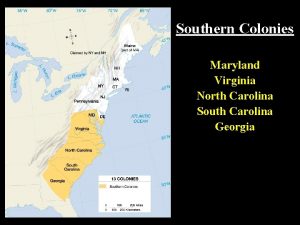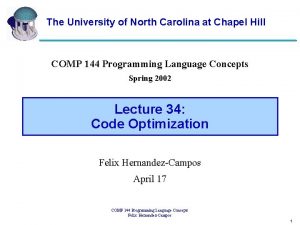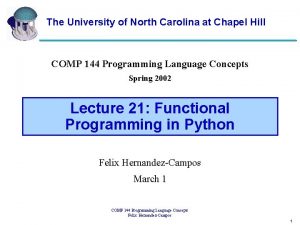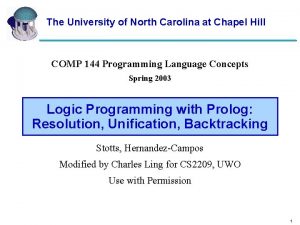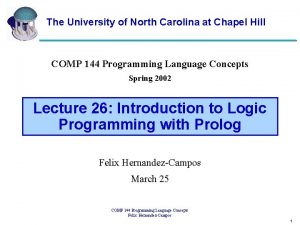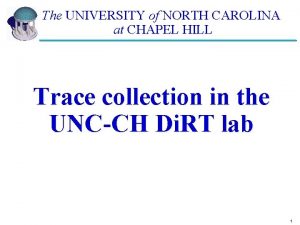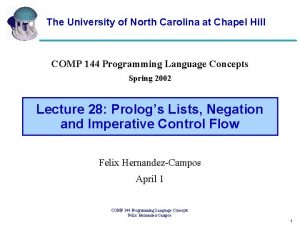The UNIVERSITY of NORTH CAROLINA at CHAPEL HILL



![Extracting Valid RTT Samples Remote end-point Monitor dat [i] ack [i] Ø Guiding principle: Extracting Valid RTT Samples Remote end-point Monitor dat [i] ack [i] Ø Guiding principle:](https://slidetodoc.com/presentation_image_h/0ea9488b3eb931facb9a77bfe4eb8089/image-4.jpg)






- Slides: 10

The UNIVERSITY of NORTH CAROLINA at CHAPEL HILL Variability in TCP Round-trip Times Jay Aikat Jasleen Kaur Don Smith Kevin Jeffay Department of Computer Science University of North Carolina at Chapel Hill http: //www. cs. unc. edu/~jasleen/research/RTT 1

TCP Round-trip Times (RTTs) Popular belief: RTTs do not vary significantly within TCP connections - Mean RTT can be used to approximate per-segment RTTs § TCP throughput models [Altman 00, Kumar 98, Lakshman 97, Mathis 97, Padhye 98, …] § Analysis based on TCP behavior - RTT of initial segments is “typical” for a TCP connection [Jiang 02] Do per-segment RTTs vary significantly within a TCP connection? 2

Data Source ibiblio web servers Regional health-care center Departments Research labs Wireless users UNC DAT UNC Campus Residence halls ACK ISP router Rest of the world VPNs Modem Monitor Rich data source! 3
![Extracting Valid RTT Samples Remote endpoint Monitor dat i ack i Ø Guiding principle Extracting Valid RTT Samples Remote end-point Monitor dat [i] ack [i] Ø Guiding principle:](https://slidetodoc.com/presentation_image_h/0ea9488b3eb931facb9a77bfe4eb8089/image-4.jpg)
Extracting Valid RTT Samples Remote end-point Monitor dat [i] ack [i] Ø Guiding principle: - Consider only those RTTs where there is unambiguous correspondence between an ACK and the DAT that triggered it. dat [i+ 1] dat [i+ 2] Ø ? ? Caveat: delayed ACKs - Could add 200 – 500 ms to RTT estimates dat [i+ 1] 2] [i+ ack 4

Trace Statistics Connections Remote hosts RTT samples Bytes Packets All connections 22. 7 million 962 K 252 million 628 GB 511 M Connections with at least 10 samples 1. 1 million 258 K 236 million 581 GB 464 M Large data set! 5

Variability Across Connections Ø 60% connections see min RTT less than 100 ms - Only 23% see max RTT less than 100 ms Ø ACKs can arrive more than 25 s after DAT transmission! Ø Mean and median RTTs are comparable measures 6

Variability Within Connections Ø Median RTT: - 30% of connections see a median RTT more than twice the min RTT Ø 90% RTT: - 22% of connections see a 90% RTT more than 5 times the min RTT - 90% RTT increases with min RTT 7

The SYN/(SYN+ACK) RTT Ø RTT yielded by the SYN and SYN+ACK pair - Differs by more than 10% from min RTT for 14% of connections - Differs by more than 10% from median RTT for 50% of connections 8

Per-Segment RTTs: Mean or Distributions? Ø Is mean RTT a good approximation for per-segment RTTs? - TCP analytical models - TCP evaluation (simulations) 9

Ongoing Work Ø Impact of RTT variability on past work - TCP analytical models - Delay-based congestion control - TCP evaluation (simulations) - TCP-based analysis Ø Causes of variability - Congestion? - End-hosts? Ø Models for per-connection RTTs - Accurate simulation environments 10
 Unc chapel hill computer science
Unc chapel hill computer science Georgia, south carolina, north carolina, virginia, maryland
Georgia, south carolina, north carolina, virginia, maryland Map of north carolina and south carolina
Map of north carolina and south carolina Maryland, virginia, north carolina, south carolina, georgia
Maryland, virginia, north carolina, south carolina, georgia Virginia, maryland, north carolina, south carolina, georgia
Virginia, maryland, north carolina, south carolina, georgia Unc pediatric hematology oncology fellowship
Unc pediatric hematology oncology fellowship Consenso de chapel hill
Consenso de chapel hill Enrolled agent chapel hill, nc
Enrolled agent chapel hill, nc Rituxvas
Rituxvas Unc chapel hill irb
Unc chapel hill irb Unc chapel hill ib credit
Unc chapel hill ib credit




